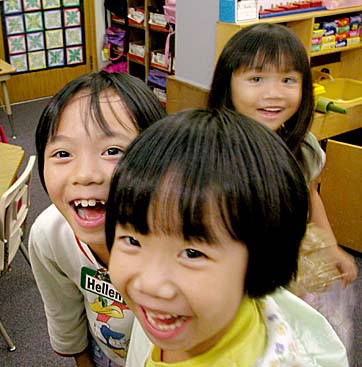
WAITING TO START SCHOOL
Hellen Chen, left, Cindy lng and Caitlyn Aradanas are kindergartners at Kauluwela School on Aala Street. Their teacher is Kelli Shirota. Under a proposed bill, children would need to turn age 5 by Aug. 1 to enter kindergarten starting in year 2006.
Proposal raises age
for kindergarten entryA two-tiered system would bring
the isles in line with other states
Children would need to turn 5 by Aug. 1, 2006, to enter kindergarten that year, but those born later in the year could enroll in "junior kindergarten" at public schools, under a bill poised to pass out of a key legislative committee today.
The proposal raises Hawaii's kindergarten age to be in line with the rest of the country while not shutting out younger children from the chance for early education in public schools.
Star-Bulletin Legislature Database
Star-Bulletin Legislature Guide
(PDF, 2.4 MB)
State Legislature: Bills
& Hawaii Revised Statutes
"Studies have shown that younger children placed in regular kindergarten oftentimes are labeled as slow or learning disabled, or just struggle," said the bill's sponsor, Sen. Norman Sakamoto (D, Salt Lake-Foster Village). "We're trying to help those kids get on the school bus instead of having to crawl after it and play catch-up for a number of years."
A proposed new draft of Senate Bill 17 would give the Department of Education a year and $100,000 to plan the new system, with another year to test it, before mandating it for the 2006-2007 school year.
Hawaii now allows children as young as 4 1/2 to start kindergarten, with a Dec. 31 cutoff date for them to turn 5, the latest in the country. Most states use an August or September cutoff for kindergarten entry. Top private schools in Hawaii generally require boys to reach age 5 by June 30 and girls by Sept. 30.
A few months can make a big difference in a child's readiness for today's academically oriented kindergartens. With Hawaii students being increasingly compared with their national counterparts, pressure has been growing to raise the kindergarten age in hopes of leveling the playing field.
But the push to raise the kindergarten age ran into opposition from parents who did not want to pay for another year of preschool and some educators who argued that keeping kids out of school longer was not the answer to shortfalls in student performance.
"We were concerned about the 'gap group' that would be excluded," said Alex Harris, policy director of the Good Beginnings Alliance. "We didn't want to be moving backwards and having the population that receives universally available public education shrink."
Creating the two-tiered kindergarten allays that concern, he said. "The legislative folks did a really nice job responding to our feedback and making kindergarten more developmentally appropriate," he said.
Because the roughly 5,000 students who would attend junior kindergarten are already accounted for in the public school system, the plan should not require wholesale changes in schools, Sakamoto said.
Overall school enrollment would not change, but different grade levels would shrink as the group of regular kindergartners starting in 2006 moves up through 12th grade. As that group is replaced by a full year's complement of students, the system could face higher costs to provide junior kindergarten.
Schools would have several options in creating the junior kindergartens, which will be explored over the next two years. They could set aside one or more classrooms, partner with a nearby public school to provide one, work with private providers or offer two tracks within one classroom.
Junior kindergartners would move up to regular kindergarten after a year. The bill gives schools flexibility to assess students' readiness and move them into appropriate grade levels.
Christian Li, foreground, and Noah Gelacio, right, playing with a Lego set, were among the Kauluwela School kindergartners in Kelli Shirota's class yesterday.
"We need to target the instruction to the level of the child," said Vern Dahl, a counselor at Maui's Kamalii School, which was cited by legislators as a model for the new system.
Kamalii assesses all new students and puts them in kindergarten classes geared to their abilities, with one functioning almost as a preschool. Children who are still struggling at the end of kindergarten get "the gift of an extra year" in a transitional first-grade class.
The school has seen its referrals to special education drop dramatically and its test scores rise under the system, which was introduced five years ago.
"Our model has worked for us," Dahl said. Children who might otherwise have felt like failures have become successful learners, he said, and high-achieving students have been challenged to even better performance.
At yesterday's committee meeting, legislators deferred the bill until today to make minor changes in language. If approved as expected at this afternoon's committee meeting, it will go to the full House and Senate for final votes.


